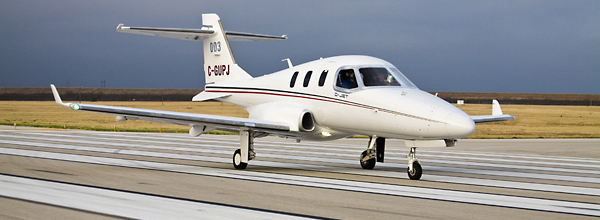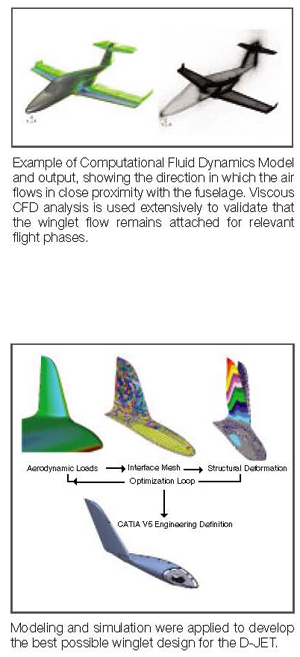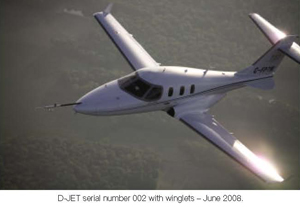 Style and Function
Style and Function
Few D-JET topics have generated as many customer questions over the past several months as the presence or absence of winglets on the flight test aircraft. The D-JET Proof-of-Concept (serial number 001) sported an initial winglet design that also was used on serial number 002 in its early days. Early photos of S/N 002 showed the aircraft with winglets. In late fall 2007, Diamond removed the winglets to test the aircraft with more “standard” wingtips while the winglets were being redesigned. As photos of the winglet-less S/N 002 and, later, S/N 003 aircraft became available,
many customers – some with considerable passion – asked whether the D-JET would permanently fl y sans winglets.
Winglets are now back, as the cover headline proclaims. They’re based on a refined design and are now undergoing fl ight test. With the expectation that the D-JET as certifi ed will, indeed, sport winglets, this technical close-up article – authored by Diamond Aircraft’s head of Flight Sciences – provides some good context for this stylish yet very functional D-JET structural feature.
Winglet Background and History
Winglets are wingtip-mounted drag reduction devices commonly found on many modern business jets, general aviation aircraft, and commercial airliners. When a wing generates lift, it also generates drag, called “lift-induced drag”. On a humid day, you can actually see one artifact of this drag – white vortices rolling off the tips of the wings and fl aps. The more lift a wing generates, the stronger these tip vortices are (or, for the technically inclined, the greater the shed vorticity). Winglets reduce the strength of these tip vortices so they reduce the induced drag of an aircraft.
Depending on the aircraft speed, weight and altitude, a signifi cant percentage of the overall aircraft drag can be due to lift-induced drag. Given the D-JET’s flight envelope, most of this induced drag occurs during climb and long-range cruise. Reducing lift-induced drag also can contribute to improved fuel economy, longer range, and potentially shorter landing and takeoff distances – all of which contribute to the D-JET’s overall affordability and utility.
The winglets on D-JET S/N 002 are a second-generation design. An initial set of winglets were designed for the Proof of Concept aircraft. Lessons learned in terms of performance and manufacturability have been incorporated into the new design. For example, the tip-mounted anti-collision and strobe lights are now mounted internally for reduced drag. The shape and angle also have been refined.
 Aerodynamic Design
Aerodynamic Design
An “optimum winglet” is a matter of perspective. The key to any winglet design is to fi nd a balance such that the benefits outweigh the penalties. This requires particular attention and expertise from a broad range of disciplines from aerodynamics, structures, avionics, marketing and flight test.
Careful optimization is still required, and a broad range of parameters is taken into account when designing the geometry of the winglet. Apart from the above-mentioned drag sensitivity, winglets also give an incremental effect to wing root bending moment, gust sensitivity, lateraldirectional stability and flutter margins.
Taking all these parameters into account, a large parametric study was done using a first-order aerodynamic panel-code. This means that several hundred winglet designs were rapidly modeled in order to determine the sensitivity to various design parameters. For example, increasing the winglet height gives more induced drag reduction, but it also increases the wing-root bending moment, and hence structural mass. Once a winglet planform was selected, higher order Computational Fluid Dynamic (CFD) methods were used to refi ne the airfoil geometry and tailor the winglet for specific wing/fuselage lift distributions.
Structural Design
The structural design of the winglet is done using an iterative process that couples the aerodynamic and structural loads. First, CFD is used to calculate the pressures that the air is exerting on the winglet at critical fl ight conditions. For example, a strong gust at high speed cruise. These winglet surface pressures, along with other loads like inertial loads) are then transferred into a Finite Element (FE) software program. Using this program, the designer determines which parts of the underlying structure carry the greatest loads and stresses, and tailors the structure accordingly. The FE program also predicts how much the winglet will deform, or “bend” under these loads. Combining the CFD and FE methods, the structure can be optimized for stiffness, weight and material selection.
Component Design and Manufacturing
CATIA v5 was used to transfer the analytical data, including aerodynamic shape and structural sizing requirements, into a functional engineering definition. This is the final step in the defi nition phase of the winglet, where the concept becomes reality and is prepared for manufacturing. Understanding the material limitations and the manufacturing processes is essential in order to ensure an aesthetic, structurally sound and cost-effective product.
The D-JET winglet uses a co-cured structural philosophy that allows it to be damage-tolerant and fully optimized. A co-cured composite design implies that the winglet consists of a single “part”. All the skins (surface shape) and skeleton (ribs, spars, underlying structure) are cured together, allowing for a substantial weight reduction.
 Flight Testing
Flight Testing
Once the winglet design was completed and the parts manufactured, they were fitted on to the D-JET fl ight test aircraft S/N 002 for Engineering Flight Test evaluation. Flight testing is done in order to get a real life validation of all the computational analysis. .
Flight test focuses on performance, stability and control, flutter and, perhaps most importantly, pilot feedback for the aircraft handling qualities. The initial testing has shown that the D-JET’s new winglets not only look great in flight and while the aircraft is parked on the ramp, but they also perform as designed
also see Diamond D-JET
